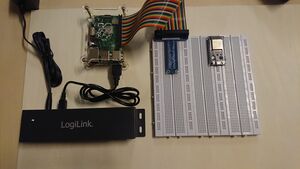Pi Lab: Difference between revisions
NitramLegov (talk | contribs) Added hdmi and sata converters |
NitramLegov (talk | contribs) m Remove this from "Looking for Collaborators", which is linked on the main page |
||
| (3 intermediate revisions by 2 users not shown) | |||
| Line 1: | Line 1: | ||
{{ProjectInfoBox | {{ProjectInfoBox | ||
|project title=Pi Lab | |project title=Pi Lab | ||
|image= | |image=Pi Lab.jpg | ||
|status= | |status=first version working | ||
|date= | |date= | ||
|initiator=[[Martin]],[[Johannes]] | |initiator=[[Martin]],[[Johannes]] | ||
|team=[[Martin]] | |team=[[Martin]] | ||
|materials=[[Raspberry Pi]] | |materials=[[Raspberry Pi]] | ||
|tools= | |tools= | ||
|software=Raspbian | |software=Raspbian | ||
|cost= | |cost=65€ | ||
}} | }} | ||
Ever since the restructuring of the [[E-Bench]] done by [[Johannes]], [[Martin]] had the idea in mind to create a [[Raspberry Pi]] based lab for quick testing of circuits and other stuff. | Ever since the restructuring of the [[E-Bench]] done by [[Johannes]], [[Martin]] had the idea in mind to create a [[Raspberry Pi]] based lab for quick testing of circuits and other stuff. | ||
This was finally built and is ready to be used for some quick prototyping with a [[Raspberry Pi]] or some other [[microcontroller]] | |||
==General Structure== | ==General Structure== | ||
The Core of the whole project | The Core of the whole project is a [[Raspberry Pi]](3B+) attached to a display and a breadboard. The Pi is connected to the breadboard using a ribbon cable and a breakout board. The breadboard offers enough room to include another microcontroller (such as an [[ESP32]]) and your components. | ||
In order to include peripherical devices, an active USB Hub is available and provides 7 USB Ports. | |||
==Software== | ==Software== | ||
For maximum compatibility, the Pi | For maximum compatibility, the Pi runs on Raspbian (Raspbian Buster with desktop, released on 2019-06-20). | ||
It will boot into the desktop where it will automatically log in using the user pi. | |||
== | ==Hardware== | ||
{| class="wikitable" | |||
|- | |||
! Part !! Source !! Price | |||
|- | |||
| Raspberry Pi (incl. Starter Kit) || https://www.pollin.de/p/raspberry-pi-3b-starter-kit-810946 || 49,95 € | |||
|- | |||
| HDMI DVI Adapter || https://www.pollin.de/p/hdmi-adapter-720967 || 1,75 € | |||
|- | |||
| 3x Laborsteckbrett || https://www.pollin.de/p/labor-steckboard-510174 || 11,25 € | |||
|- | |||
| Pi Breakout board || https://www.reichelt.de/raspberry-pi-t-cobbler-plus-rpi-t-cobbler-p-p235529.html || 3,60 € | |||
|- | |||
| Display || Already available || | |||
|- | |||
| Keyboard || Already available || | |||
|- | |||
| Mouse || Already available || | |||
|} | |||
==Further Hardware considerations== | ==Further Hardware considerations== | ||
| Line 37: | Line 50: | ||
* [https://www.reichelt.de/raspberry-pi-shield-oszilloskop-10-kanaele-vel-vm205-p148930.html Oscilloscope HAT] | * [https://www.reichelt.de/raspberry-pi-shield-oszilloskop-10-kanaele-vel-vm205-p148930.html Oscilloscope HAT] | ||
* Microscope | * Microscope | ||
* External Hard Disk | * External Hard Disk | ||
** This also requires a SATA-->USB converter including a power supply for the HDD | ** This also requires a SATA-->USB converter including a power supply for the HDD | ||
[[Category:Electronics]] | |||
[[Category:Raspberry Pi]] | |||
Latest revision as of 06:54, 2 September 2022
| ProjectInfoBox Pi Lab | |
|---|---|

| |
| Status: | first version working |
| Initiator: | Martin,Johannes |
| Team: | Martin |
| Materials Used: | Raspberry Pi |
| Software Used: | Raspbian |
| Approx. Cost: | 65€ |
Ever since the restructuring of the E-Bench done by Johannes, Martin had the idea in mind to create a Raspberry Pi based lab for quick testing of circuits and other stuff.
This was finally built and is ready to be used for some quick prototyping with a Raspberry Pi or some other microcontroller
General Structure
The Core of the whole project is a Raspberry Pi(3B+) attached to a display and a breadboard. The Pi is connected to the breadboard using a ribbon cable and a breakout board. The breadboard offers enough room to include another microcontroller (such as an ESP32) and your components.
In order to include peripherical devices, an active USB Hub is available and provides 7 USB Ports.
Software
For maximum compatibility, the Pi runs on Raspbian (Raspbian Buster with desktop, released on 2019-06-20). It will boot into the desktop where it will automatically log in using the user pi.
Hardware
| Part | Source | Price |
|---|---|---|
| Raspberry Pi (incl. Starter Kit) | https://www.pollin.de/p/raspberry-pi-3b-starter-kit-810946 | 49,95 € |
| HDMI DVI Adapter | https://www.pollin.de/p/hdmi-adapter-720967 | 1,75 € |
| 3x Laborsteckbrett | https://www.pollin.de/p/labor-steckboard-510174 | 11,25 € |
| Pi Breakout board | https://www.reichelt.de/raspberry-pi-t-cobbler-plus-rpi-t-cobbler-p-p235529.html | 3,60 € |
| Display | Already available | |
| Keyboard | Already available | |
| Mouse | Already available |
Further Hardware considerations
This is a list of stuff we could possibly think about. However, we have to check if we really need these things (so far this list is just a braindump)
- Logic Analyzer
- Oscilloscope HAT
- Microscope
- External Hard Disk
- This also requires a SATA-->USB converter including a power supply for the HDD